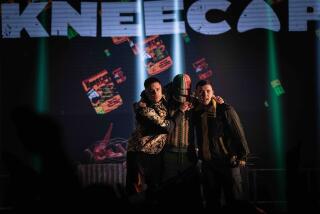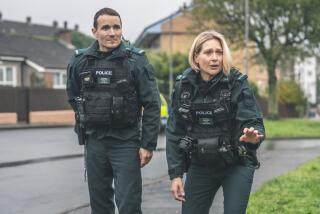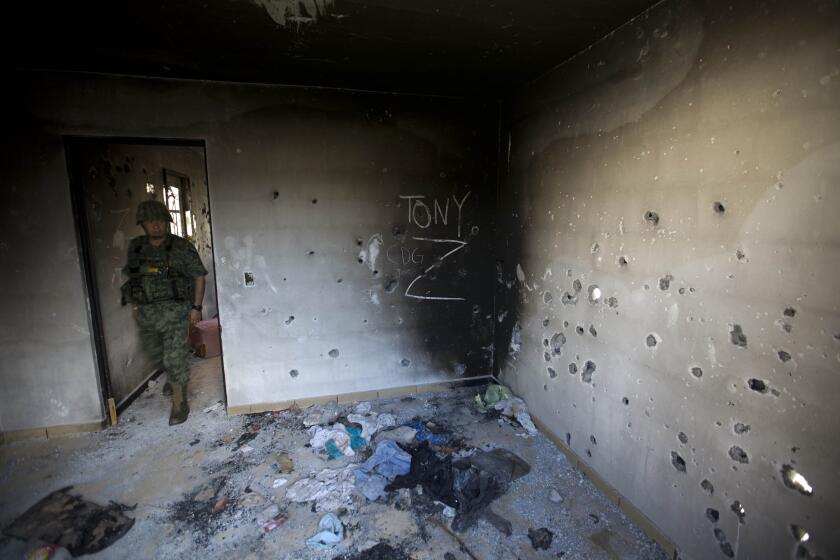Defector Takes On the IRA
LONDON — Sean O’Callaghan is an old-looking 42, his shaggy mustache gray, his trigger finger nicotine-stained as he flits warily through London, a metropolis he grew up believing was the enemy capital.
Today, O’Callaghan is a unique and reviled figure in the twilight world of violent Irish nationalism. A killer-turned-informer, he is “most wanted” by the militant Irish Republican Army. He is Judas on the run.
“I’ve no fixed address, no bank account, a cell phone in somebody else’s name. I stay away from the Underground [subway],” he said, loping toward an anonymous cab after a long interview on the eve of his first visit to the United States, where he will spend the next three weeks, including a stop in Los Angeles.
O’Callaghan believes that he is safer in the United States. Released in December after serving eight years of a 539-year terrorism sentence, he declined the shelter of a witness-protection program in Britain despite an IRA price on his head.
Instead, he is emerging from the shadows as an outspoken skeptic and peacemonger who recounts stranger-than-fiction stories with a pointed message. “Never trust the IRA,” he will tell one and all on his self-financed U.S. visit.
“I kind of accept that the IRA has the right to kill me. If they succeed, I would say, ‘Fair dues,’ ” said O’Callaghan. He is a soldier once again at war--but this time against the organization that taught him to kill.
It would be a “huge underestimation,” he said, to believe that the IRA is ready to end its armed struggle to unite British-controlled Northern Ireland with the Republic of Ireland despite the peace negotiations sought by its political arm, Sinn Fein. “The IRA has not changed,” he said. “It is just more sophisticated. The peace process has been a sham from the beginning.”
Only a joint stand by Britain, Ireland and the United States warning that there must be a final end to violence has any chance of winning peace, he argued.
O’Callaghan himself rocketed to IRA stardom in the 1970s. As a teenage IRA “volunteer,” he killed a female soldier and a police detective. He took part in more than 70 armed attacks and bank robberies. At 25, he was a senior terrorist commander.
Disaffected by mindless violence and the callousness of his colleagues, he eventually betrayed the hard men of the IRA, defying his comrades and his heritage to become what British and Irish police privately call the most damning and effective police informer across the bloody decades of Northern Ireland’s political violence.
In 1983, he said, he averted the planned assassination of Prince Charles and Princess Diana. Later, he was responsible for the capture of tons of arms sent by boat to the IRA by admirers in the United States.
Much of what O’Callaghan has said is at least partly corroborated by outside sources. Former Irish Prime Minister Garret Fitzgerald, for example, said he knew of the short-circuited attempt on the lives of the royal couple. One Irish cop has called O’Callaghan “the most important intelligence agent in the history of the Irish Republic.”
As the most senior IRA commander ever to defect, O’Callaghan has more guns-blazing insider’s stories to tell than anyone has ever told publicly. Wrapped deeper is the personal story of an Irishman who was born to the republican struggle--only to become consumed and then repulsed by it.
O’Callaghan said he snapped one night in 1974 while at a safe house at 11 Mill St. in the town of Monaghan, Ireland. When the IRA commander whom O’Callaghan most admired learned that a female police officer had been killed, his reaction was: “I hope she was pregnant, and we got two for the price of one.”
“I walked down the stairs to one of the bedrooms and burst out crying,” O’Callaghan said. “There was nowhere to go.” He was 20, already a veteran killer, bomber, bank robber.
“As an extremist, I was fine once it was remote--the British government or the British army. But when it was a scouting mission to the guy that lived a quarter of a mile down the road, to have a look at him to kill him, it all became a bit . . . different,” he said softly, breaking the tip off a filtered cigarette.
In the United States, O’Callaghan will talk about the darker side of peace efforts in Northern Ireland. The IRA has never sought peace, he will say: An 18-month cease-fire there that began Sept. 1, 1994, was no more than a ploy by political gangsters, a trick that they will try again.
But the man is also the message.
This year, Sean O’Callaghan will see the United States for the first time in the run-up to St. Patrick’s Day because the U.S. government says it is “in the national interest” to allow him in, despite his terrorist past.
A similar visa waiver carried Sinn Fein leader Gerry Adams as far as the White House in years past. With the IRA killing again, Adams is not welcome this year, the U.S. government has quietly made plain.
Instead, there comes his fellow republican O’Callaghan, who now believes that there is no honor, much less romance, in the violent IRA struggle to unite Northern Ireland and its minority Roman Catholic population with Ireland.
Adams denies all of O’Callaghan’s specifics and all his generalities and calls him “a nut case.”
Born in Tralee in County Kerry, an IRA bastion in the south of Ireland, O’Callaghan joined the IRA when he was 15. There was an inevitability about it. Over the years, a grandfather, his father, an uncle and some aunts all had been jailed by the British. It was a great adventure, fighting as a soldier in a clandestine army, but the IRA reality he encountered in Northern Ireland never lived up to the folklore, O’Callaghan said.
“I came with a romantic . . . view that we were fighting the police and the army, but that’s not what it was about. There was this deep-rooted hatred on both sides between Catholics and Protestants, who they perceived as having taken their land.
“The IRA wasn’t really after the British,” he said. “It was the guy down the road who had the better land that his ancestors had taken from the Catholics. The bitterness was there all the time, rooted and deep. What they really wanted to do was to murder their neighbors. It was tribalism.”
Nothing has changed, O’Callaghan lamented. “If you join the IRA in areas of Belfast today, you’re not rebelling against anything. It’s almost an establishment thing to do,” he said. “You go to the local IRA man for almost anything. He becomes the mythological sort of old-type don, you know, the man of honor, who sorts out the problems.”
Adams sorts out problems. Despite his politician’s image today, O’Callaghan said that Adams is, as ever, the IRA’s man. Like the British government, he rejected Adam’s assertion that there is a defining line between the bomb-planting IRA and the democratically elected Sinn Fein.
O’Callaghan said he discussed arms imports and assassination lists with Adams. “The IRA has discussed killing everybody. It constantly discusses killing people that might be a threat to them,” O’Callaghan said. “I have never heard IRA business discussed in Sinn Fein meetings, but I’ve attended countless IRA meetings where I’ve heard Sinn Fein business discussed. The IRA remains very much a big brother.”
O’Callaghan was arrested for the first time in 1972, when he was an 18-year-old IRA bomb instructor. He told a British court that he participated in 70 armed attacks in one 14-month period. He fired a mortar that killed the female soldier, and in May 1974, he and two other youths gunned down police Inspector Peter Flanagan in Broderick’s Bar in Omagh, a small town in Northern Ireland.
Despite their success in killing a “prestige target,” the 18-year-old getaway driver said she felt sorry for the inspector’s mother. And O’Callaghan was having his own reservations: “It was ridiculous. This thing flashed into my head and said, ‘You’ll have to pay for this someday.’ And I went, ‘What a load of crap,’ because it had no place in my thinking at all. It was such a ridiculous thing, because I was an IRA volunteer soldier. . . . The idea that I could have done something wrong didn’t get into the equation at all.”
After his epiphany on Mill Street, a burned-out O’Callaghan moved to England with the permission of the IRA. He married and opened a small retail shop. Neither venture prospered.
All the while, he said, the past weighed on him. He made a decision to return to Ireland. But when he went back in 1979, it was as an unpaid informer for the Garda Siochana, the Irish national police.
O’Callaghan said his decision to turn on the IRA took years of soul-searching. “Why didn’t I come back to England and write about the IRA and just condemn them? Because I had murdered a couple of people, and if you don’t tell the truth, it sounds like nonsense,” he said. “I knew that the way to destroy the IRA was to work inside it.”
Going undercover with a display of vigorously renewed commitment, O’Callaghan quickly became head of the IRA’s Kerry operations. Then he was made chief of the IRA Southern Command, which is responsible for operations against Britain. He became a Sinn Fein City Council member in Kerry, and a member of the Sinn Fein national executive and the IRA high command.
According to O’Callaghan, the IRA resolved to kill Charles and Diana in 1983. He was ordered to plant a bomb in the men’s room near the Royal Box at London’s Dominion Theatre during a performance to be attended by the royal couple.
The assignment confronted O’Callaghan with an impossible conflict of interest: To kill the royals would be wrong, he believed, and it would bring rage down on the Irish community. On the other hand, to refuse the assignment would risk exposing himself as a double agent.
O’Callaghan said that with the aid of British and Irish security agents he finessed the crisis. As preparations for the bombing advanced, police suddenly announced that O’Callaghan was a wanted IRA leader.
With such publicity, IRA leaders concluded that they could not risk using O’Callaghan as the assassin. And neither was there enough time for the IRA to find a replacement. The mission was aborted.
After the close call, O’Callaghan remained an IRA leader, but by 1985 it was clear that the IRA was suspicious of him, he said.
Again, he asked for a leave and went to England, living quietly there for three years. Then in 1988 he walked into a police station and said he had a confession to make.
In 1990, after two years in jail, he was convicted on his own testimony of two murders and 42 terrorist offenses.
Hearing a judge sternly sentence him to 539 years did not make a great impression on O’Callaghan. “The average life sentence in Northern Ireland is 11 years,” he said. “I thought I’d do 10. But I got out two years early.”
In the IRA-friendly media, O’Callaghan is portrayed as a liar, a drunk, a British stooge.
“When I left Ireland in ‘85, I was certainly one of the 20 most senior republicans in Ireland. When did I become a fantasist and the drunkard?” he asked. “What somebody like me is supposed to do is go away and shut up. But here I am, I’m an informer, and kind of a little bit pleased with the results.”
If the IRA had killed the royal couple, what would have been the repercussions for the Irish community in Britain? O’Callaghan asked. He also believed that he helped save many lives by revealing a 1984 plot to smuggle $2 million worth of arms collected by IRA supporters in the Boston area into Ireland aboard the vessel Valhalla. “Those are the questions I keep bringing up. And nobody answers them because they say, ‘Ah, here’s a fantasist, and he’s a stooge.’ ”
O’Callaghan hopes that his U.S. tour, which will include testimony to Congress and university and television appearances, will drum up interest in a novel he is completing. He’s also a poet and an occasional newspaper columnist here and dreams of being able to make a living by writing.
But he knows that wherever he is, he will always have to look over his shoulder. The IRA has a long memory, he said.
“I’m seriously hoping that they never get lucky,” O’Callaghan said, “but I’m kind of at war with them, so if they get lucky and kill me, I can’t really say it’s unfair.”
More to Read
Sign up for Essential California
The most important California stories and recommendations in your inbox every morning.
You may occasionally receive promotional content from the Los Angeles Times.










